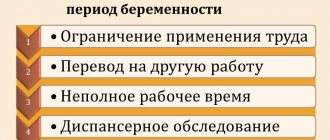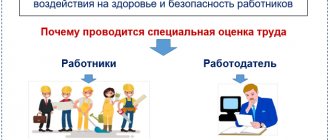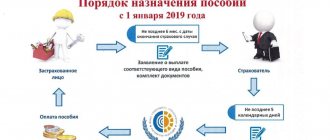Working conditions in the workplace are an important aspect of the labor relationship between employer and employee. When applying for employment, a candidate for a position has the right to know in what conditions he will have to work, and therefore the characteristics of working conditions must be spelled out in the employment contract. From this article you will learn what is meant by working conditions, what are the established characteristics of the production process, what is the production environment and labor intensity, what is the classification of working conditions, what environmental factors pay special attention to, how workplace certification is carried out, how to formulate provisions on working conditions in the employment contract, what compensation is provided for harmful/dangerous working conditions, and what to do if working conditions worsen during work.
What is meant by working conditions
Working conditions are a set of factors that influence how comfortable and safe an employee is to perform his job duties at his workplace. Over the years, the labor protection system has been continuously improved, and today we can talk about fairly clear criteria for assessing working conditions. The law requires the employer to create the most comfortable working conditions for its employees, but the main thing is that the work must be safe, not threatening the life/health of the subordinate himself and his future children.
Current labor legislation obliges the employer to notify new employees about working conditions in production even at the time of familiarization with the contract:
- Article 56 of the Labor Code of the Russian Federation states that the head of an enterprise is obliged to ensure working conditions provided for by law;
- Article 57 of the Labor Code of the Russian Federation obliges employers to include a description of working conditions in the contract and mention all the harmful factors of production that a subordinate will encounter (it is also necessary to specify what guarantees and compensation payments are provided).
Related nuances
In addition to these standards, you should also take into account a number of other points that are associated with the procedure for drawing up an employment contract for each of the parties.
| Situation | How to register |
| Additional leave | The employee receives paid leave, which he can take once a year for a period of 28 calendar days. Due to the fact that the employee performs work duties in conditions that are considered to be of the second degree of harm, he is provided with additional paid leave, the duration of which is 7 calendar days. |
| Accrual of bonus | The employee receives a monthly salary of 50,000 rubles. Due to the fact that the employee operates in conditions that are classified as harmful, he is assigned an additional payment of 4% of the monthly salary. |
| Shortening the working week | The employee works on a five-day working week with a total work duration of 36 hours for the reason that his activities are carried out in conditions that are classified as third degree hazardous. Weekends – Saturday, Sunday. |
| Based on the collective agreement and industry agreement, the employee performs his duties for 40 hours a week. | The employee works on a five-day work week with a total work time of 40 hours. For the fact that his activities are carried out in conditions related to the third degree of harmfulness, he receives an additional payment in the amount provided for by the formalized collective agreement, taking into account the industry agreement. |
Making additions
The provisions of Article 57 of the Labor Code state that any additional points must be spelled out during the process of hiring an employee.
This procedure is carried out as follows:
- it is determined under what conditions the employee will work, specifying the class in accordance with the standards of executive certification;
- all certification results are supported by relevant documents;
- adjustments are made with the consent of each party.
https://youtu.be/x0yw8ENVdsE
Characteristics of working conditions in an employment contract
The employment contract must specify the characteristics of the production process - activities aimed at transforming raw materials into the final consumer product. The production process can be characterized by:
- raw materials and materials available at the beginning;
- the means by which production is made possible;
- the type of labor involved.
This means that in order for an employee to imagine what he will encounter during his work, it is necessary to characterize the work process as accurately as possible at the stage of drawing up an individual employment contract. For example, if a future employee knows that he will have to work in a metallurgical plant, he can already assess how acceptable the working conditions will be for him. If the conditions are difficult, compensation for difficult work, additional privileges and guarantees can convince people to get a job.
How changes are entered
According to legal standards, an assessment of the characteristics of the work environment must be carried out at least once every 5 years, and in some cases more often if required by the industry.
Since certification is a complex and lengthy matter, it is carried out with minimal frequency, and over a long period conditions can indeed change.
This can be achieved by upgrading the production process or making other adjustments, and in any case an assessment should be carried out, and if such conditions change, the contracts will also need to indicate the changed data.
Photo: classification of activities by degree of harmfulness
For the better
If employment conditions were classified as 3-4 classes, and after assessment activities improved to acceptable or optimal, then an additional agreement should be drawn up.
It notes on what basis the changes were made and what state was recorded at the time of preparation of the document.
At the same time, factors that led to the provision of additional guarantees and benefits are excluded.
Video: what the agreement should contain
For the worse
According to Article 8 of the Labor Code of the Russian Federation, if the situation worsens, previously valid employment contracts are invalid because they do not reflect the current situation.
Thus, in an agreement, if harm is assigned more than it was previously, it is necessary to correct the classification, and also take care to introduce into the text a whole list of benefits and compensations that were initially guaranteed by legislative acts.
To fully comply with legal requirements, it is also necessary to inform all subordinates about the changes, as well as the benefits and additional payments due to people.
It will be equally important to notify them of the possible consequences that may arise in the form of injuries or occupational diseases.
This must be done within a month after the changes are made to give those who disagree with such conditions the opportunity to change their occupation.
This is the only way to achieve compliance with legal nuances and not become a violator of the law.
What is meant by labor intensity?
Labor intensity is the most important indicator of the production process. We can say that we are talking about the intensity of the labor process. The same work can be organized in different ways - in one case the employee will get tired quickly, but at the same time achieve insignificant results, in another situation the employee will have time to do much more, but will not be so tired.
In this case, the fate of the enterprise depends on the literacy of management. If the workplace is poorly organized, productivity will suffer. Conversely, if a combination of various factors, including psychological ones, do not lead to an excessive increase in work intensity, employees perform their work efficiently and achieve optimal results.
Characteristics of working conditions in an employment contract: classification of working conditions
Important! Current legislation considers four classes of working conditions - the 4th is considered the most harmful and dangerous.
So, in the employment contract it is imperative to indicate to which hazard class the production process belongs, and what factors worsen working conditions.
| Conditions | Characteristic |
| Optimal | Harmful production factors are either completely absent or at an acceptable, completely low level. Employees are not exposed to any harmful factors, their health does not deteriorate during work, they have time to rest and recuperate during breaks and weekends. |
| Acceptable | Any harmful factors are present, however, their impact is within strictly established limits. Workers experience discomfort, physical or psychological, but do not experience a deterioration in their health. There is enough rest time to recuperate. |
| Harmful | It was noted that the level of exposure to harmful or dangerous production factors on the employees’ bodies was exceeded. There is a risk of injury or occupational disease. There is not enough rest time to fully recuperate, health gradually deteriorates, and there may be a need to leave work early due to decreased ability to work. |
| Dangerous | The influence of negative factors does not stop throughout the working day, and there is a deterioration in health and general condition. Occupational diseases inevitably arise, and with long-term work, the ability to work in relation to any work is lost. Future generations may also be harmed. |
Actions of both sides
The need for an unscheduled certification may arise if a major overhaul of the premises or equipping it with some modern equipment is required. There is also a need for inspection if a significant malfunction of the air purification system and other equipment has been detected. The same applies to any unforeseen situations, including an employee being injured at work.
https://youtu.be/pdVZh5Yv4Pw
If the employer refuses to carry out re-certification or repair the breakdown, then in this case his employees have the right to submit an appropriate appeal to the trade union committee with a request for an extraordinary certification or to contact the State Labor Inspectorate. As a last resort, you can file a report with the prosecutor's office.
Maximum permissible indicators of environmental factors
When hiring an employee, it is also necessary to inform him about a workplace assessment, which includes measurements of the most important physical factors. Biological and chemical factors such as exposure to toxic substances, dust concentration, etc. must also be checked. Physical factors include the following:
| Factor | Norm |
| Vibration | General and local vibration are distinguished. The maximum permissible values of the standardized parameters of industrial local vibration are 126 dB (vibration acceleration), 112 dB (vibration velocity). |
| Noise | 65 dB – noise level, 75 thousand Hertz – frequency. |
| Temperature | If there is active physical work, a temperature of 10-16 C is considered normal, if the worker’s activity is average - 18-23 C. |
| Lighting | The norm is 1000-2000 Lux. |
Special assessment of working conditions
Important! Since January 2014, even office certification is mandatory.
The certification of workplaces, which was carried out by a professional certified commission once every 5 years, has been replaced by a special assessment of working conditions. The employer is obliged to involve specialists to carry it out in order to promptly learn about the deterioration of working conditions, the impact of harmful factors on workers, the presence of areas of production premises hazardous to health and life, etc.
During the assessment, the indicators of biological, chemical and physical factors are measured. Typically, employers carry out special assessments of workplaces every few years, when there is a significant change in the production process or when accidents occur. If it turns out that the workplace does not meet the approved standards, the employer decides how to improve working conditions.
Assessment of workplaces
The employer himself is responsible for certification of workplaces. A certified organization that professionally deals with this is directly involved in certification.
For certification, a special commission is formed, consisting of the employer (his representative), a labor protection specialist for the enterprise, and trade union members.
After this, specialists from the hired certification company, together with the commission, inspect workplaces and collect data.
We invite you to read: How to draw up a custody agreement between individuals: sample
Environmental factors are measured - noise, vibration, deviations from the norms are recorded. The final report contains factor measurement data. If workplaces are similar to each other (in terms of equipment, environment, etc.), then it is allowed to inspect one fifth of similar workplaces. But at least two places.
There is a distinction between scheduled and unscheduled certification.
The plan is provided every five years.
Unscheduled certification is carried out for all significant changes in the production process.
These include replacing equipment, switching to a fundamentally different technology. production process, as well as the request of the trade union.
Attention! An accident at work is a good reason for an unscheduled inspection.
The final conclusion of a special assessment of working conditions states whether the workplace complies with established standards or not.
Attention! Since January 2014, the certification rules have changed significantly. In particular, the changes affected the office sector. Office certification is now also mandatory.
Characteristics of working conditions in an employment contract: wording
In an individual employment contract, it is necessary to mention what working conditions are created at the enterprise. You need to write the following:
- Highlight a new section of the contract, call it “Labor Safety”, indicate the class of conditions (1 – “optimal”, 2 – acceptable, 3 – harmful (indicating the degree of impact of negative factors), 4 – dangerous).
- List the harmful and dangerous factors affecting employees during the period of work.
- Write about the possible consequences of working under the influence of harmful factors, if working conditions are not optimal and unacceptable (deterioration of health, occurrence of occupational diseases, harm to the future generation, loss of ability to work, etc.).
- Talk about the compensation and guarantees that an employee who works in harmful and dangerous conditions receives. This is a salary increase (minimum 4%), additional vacation, free milk and other privileges at the discretion of the employer.
Follow the link to view ⇒ Sample employment contract (the “working conditions” items are filled in).
Follow the link to view ⇒ Sample employment contract (harmful working conditions in the workplace).
Harmful and dangerous UT
The third class includes harmful environmental pollution – when the level of exposure to harmful factors is higher than permissible.
Within the third class, four subclasses are distinguished (depending on the increasing level of impact):
- harmful OT of the first degree: the employee does not have time to recover;
- harmful hazards of the second degree: when working in such conditions for more than fifteen years, occupational diseases of mild severity may occur without loss of ability to work;
- harmful hazards of the third degree: when working in such conditions, it is likely to acquire an occupational disease of mild/moderate severity with loss of professional ability to work;
- harmful UT of the fourth degree: can lead to severe forms of occupational diseases with loss of the employee’s general ability to work.
The fourth class, the highest, is dangerous UT. Working in them threatens the worker’s life and carries a high risk of acute occupational diseases.
The establishment of a class (subclass) of labor protection, in addition to labor protection measures, affects the size of the additional tariff of insurance contributions made by the employer to the Pension Fund of the Russian Federation: the better the working conditions, the lower the amount of contributions.
Expert opinion on what to do if a deterioration in working conditions is noticed
It happens that an employee gets a job because he is satisfied with the working conditions specified in the contract. However, after a while he notices changes in working conditions and increased exposure to harmful factors. Experts from the State Labor Inspectorate advise in such cases to report deteriorating working conditions to the employer. If the changes are of a domestic nature, for example, the lighting is faulty, the employer will contact the subordinate responsible for labor protection at the enterprise. The defect will be fixed.
If the employer ignores the words of the employees, it is necessary to contact the trade union organization and demand an unscheduled special assessment of workplaces. If management disagrees, it is possible to file a complaint with Rostrud, the prosecutor's office and the court - if a significant deterioration in working conditions is detected, the employer will be fined.
Salary
The management of the organization is directly interested in improving working conditions at the enterprise.
This leads to both lower taxation and lower labor costs. Therefore, from one certification to another, a set of measures is carried out aimed at reducing harmful factors.
We invite you to familiarize yourself with how bailiffs conduct an enforcement search for a debtor
The most successful levers for this are:
- Modernization of technical equipment of production.
- Use of personal and collective protective equipment.
Occupational safety and health services work towards continuously reducing the levels of harmful effects of various factors.
Any incident may result in an unscheduled special assessment. And in some cases, it may be initiated by inspection authorities, suspecting that the results do not correspond to the truth. Whatever the reason for the new certifications, their results must be reflected in the employment contract.
Employers strive to improve existing working conditions, but in practice this does not always work out. But any change in one direction or another must be specified in the contract.
Sometimes it happens that when hiring a person, the conditions are not specified in the contract due to the lack of an assessment. In practice, this is legally permitted for those places that were primarily introduced for work. The employer has 12 months to certify this position. Whatever the results obtained, the employee must be familiar with them.
The Labor Code establishes that, although improvement is prescribed in the contract, it does not require the use of additional measures, but deterioration will enable the employee to demand a transfer to another place of work. The employer is obliged to offer him a choice - to remain in his previous position and receive the benefits he is entitled to by law, or to move to another one so as not to harm his health.
Changes to a previously drawn up employment contract are made by drawing up an additional agreement. The additional agreement is prepared in two versions; one copy will be kept by the employee and the other by the employer.
In addition to signing, the employee must express his consent with the phrase “I have read the changes and do not object.” He also has the right to object in writing or by refusing to endorse the agreement. But refusing to sign does not always lead to pleasant changes. If the deterioration in labor was justified, and there are no vacancies for transfer to another position, then the employment relationship may be interrupted.
Properly drawn up labor documentation allows you to avoid conflict situations and lawsuits.
According to the Labor Code of the Russian Federation, the terms of remuneration in the employment contract are considered mandatory working conditions in the employment contract.
Payment information must contain:
- the amount of remuneration of the employee;
- all additional payments due;
- all applicable allowances;
- incentives and compensation.
The employer must also provide for the consistency of the conditions for remuneration of the employee in the employment contract when working in “special” conditions:
- carrying out labor activities overtime;
- going out at night;
- carrying out work on weekends and holidays.
In the document concluded between the employer and the company employee, among other things, it is necessary to determine the place, procedure and time of salary payment, and display the form of payment of wages:
- monetary equivalent;
- combination of cash equivalent and other forms of payments.
Based on the above, it is logical that if such a need arises as making certain changes to the existing payment terms and their stability, the corresponding data should also be reflected in documentary form.
In this case, you need to rely on Article 74 of the Labor Code of the Russian Federation.
Legislative acts on the topic
| Art. 56 Labor Code of the Russian Federation | On the employer’s obligation to provide proper working conditions for employees |
| Art. 57 Labor Code of the Russian Federation | On the mandatory inclusion in the employment agreement of a clause describing working conditions |
| Art. 14 Labor Code of the Russian Federation | On the classification of working conditions |
| Art. 224 Labor Code of the Russian Federation | On payment of compensation for harmful working conditions |
| Art. 147 Labor Code of the Russian Federation | On the minimum amount of compensation for harmful work |
Guarantees and compensation
The legislation of the Russian Federation provides for the payment of compensation and the provision of additional social guarantees to people whose activities are related to harmful or dangerous working conditions. The amount and type of compensation by the employer can be selected individually, but only in accordance with the established provisions of the Labor Code of the Russian Federation:
- Increased wages, 4% or more of the standard salary.
- Free vouchers for treatment and recovery in a sanatorium.
- Additional days of annual paid leave.
- Issuance of the necessary equipment and protective clothing to protect the respiratory system, vision and hearing from negative impacts.
- Shorter working hours and longer rest for full recovery.
It is important to know! Not only the requirements of the law are taken into account, but also the provisions of collective agreements. The main points regarding the provided compensation and guarantees are necessarily written down there.
Common mistakes
Error: The employer did not indicate in the employment contract the hazard class of work at the enterprise.
Comment: Working conditions, in particular the hazard class, must be specified in the employment contract without fail.
Error: The employee took a hazardous job, after which he decided to go to work part-time at another enterprise with hazardous working conditions.
Comment: You cannot take part-time hazardous work if your main place of work involves performing work duties under the influence of harmful production factors.
Causes of deterioration
If an employee discovers any critical changes that may ultimately lead to aggravation of existing harmful factors, he must inform the employer about this.
If the latter ignores this message, a new certification should be demanded through the trade union. If the employer ignores this requirement, he will face serious fines.
In the event that the deterioration is mostly of a domestic nature, it is enough to simply contact an authorized employee of the company who is responsible for ensuring labor safety so that he can eliminate the defect without loss of quality.
Attention!
- Due to frequent changes in legislation, information sometimes becomes outdated faster than we can update it on the website.
- All cases are very individual and depend on many factors. Basic information does not guarantee a solution to your specific problems.
That's why FREE expert consultants work for you around the clock!
- via the form (below), or via online chat
- Call the hotline:
APPLICATIONS AND CALLS ARE ACCEPTED 24/7 and 7 days a week.
Answers to common questions about the characteristics of working conditions in an employment contract
Question No. 1: Can an employer not conduct a special assessment of jobs if we are talking about office work?
Answer: No. Since January 2014, a special assessment is mandatory even when working in an office.
Question No. 2: Is it possible not to conduct a special assessment of each workplace if the workplaces are similar?
Answer: You can, but you will have to check at least 2 such workplaces, not just one.
Rate the quality of the article. Your opinion is important to us:











